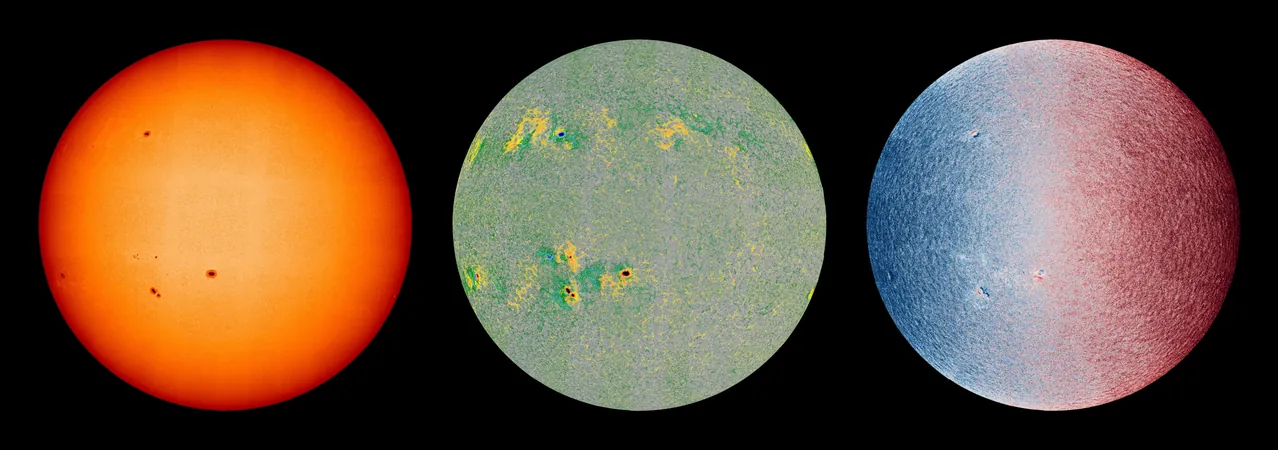
Astonishing New Sun Views Unveil Sunspots and Turbulent Plasma
2024-11-21
Author: Emily
Introduction
The Sun, the centerpiece of our Solar System, continues to amaze scientists with its dynamic and multifaceted nature. The European Space Agency (ESA)-led Solar Orbiter mission has taken on the monumental task of observing our star using an impressive array of six imaging instruments. This mission is peeling back the Sun’s layers to reveal a variety of intriguing phenomena.
High-Resolution Observations
In a groundbreaking update, the Solar Orbiter has provided the highest-resolution full views of the Sun's visible surface, known as the photosphere, ever captured. These stunning images are produced by the spacecraft’s Polarimetric and Helioseismic Imager (PHI), which not only photographs in visible light but also gauges the Sun's magnetic field's orientation and maps the velocity of surface movements.
Significance of Data
The significance of PHI's data is amplified when compared to images of the Sun's outer atmosphere, the corona, captured by the Extreme Ultraviolet Imager (EUI) on the same day in March 2023. The EUI takes images in ultraviolet light, providing complementary information critical for understanding the Sun's activity.
Magnetic Field and Plasma Dynamics
"The magnetic field of the Sun is crucial for decoding its dynamic behavior. The new high-resolution maps from the PHI instrument showcase the intricate details of the Sun's surface magnetic field and its plasma flows," explains Daniel Müller, Project Scientist for Solar Orbiter. He emphasizes that these observations are essential for inferring the magnetic field in the Sun’s hot corona, which can significantly affect space weather conditions impacting Earth.
Surface Activity and Tempatures
In a captivating display, zooming into the PHI images reveals the Sun’s surface teeming with glowing, hot plasma, a charged gas that constantly shifts and flows. The temperature in this layer ranges from a blistering 4500 to 6000 °C, emitting most of the radiation that reaches Earth. Beneath this surface, the convective motions are akin to Earth's magma flows, resulting in a textured, grainy appearance that underscores the Sun's active nature.
Sunspots and Magnetic Influence
Notably, sunspots dominate these images, appearing as dark patches against the brighter surroundings. These cooler regions are less luminous due to their relatively lower temperatures. The accompanying magnetic map reveals that this unique magnetic field concentrates strongly in sunspot areas, influencing the behavior of plasma and explaining the lower temperatures found within these spots. As a result, convection, which typically carries heat from the Sun’s interior to its surface, is disrupted by the magnetic forces at play.
Dynamic Solar Material Movement
In addition, distilling the movement of solar material, PHI's velocity map – termed a tachogram – illustrates the intricate dynamics at play. The blue regions indicate movement toward the spacecraft while red signifies motion away. This map reveals that while the Sun’s surface generally rotates with its overall spin, active regions like sunspots alter plasma's outward flow.
Insights from the Coronagraph
The EUI’s stunning visuals of the corona provide insights into the activity above the photosphere, showcasing glowing plasma jets that extend outward from sunspot regions. This hot plasma, reaching millions of degrees, is dramatically shaped by the Sun’s magnetic fields, often forming connections between neighboring sunspots.
Data Collection Process
To create these intricate images, the Solar Orbiter captured data from an impressive proximity of less than 74 million kilometers from the Sun. Given the spacecraft's close position, each individual high-resolution image only captured a fraction of the solar surface. The process of capturing this extensive data required precise tilting and rotating of the spacecraft to ensure every segment of the Sun was photographed.
Mosaic Assembly and Processing
The full-disc images have been meticulously assembled like a mosaic. Each image consisted of 25 distinct captures, taken over a period exceeding four hours. With the Sun’s disc depicted at nearly 8,000 pixels in these mosaics, the level of detail is astonishing.
Challenges and Future of Solar Studies
The image processing involved in creating the PHI mosaics was an unprecedented challenge, but this accomplishment lays a foundation for more rapid future processing, with the PHI team anticipating the ability to generate these high-resolution mosaics twice a year.
Conclusion
As the Solar Orbiter continues its mission, the revelations about the Sun’s behavior and structure promise to deepen our understanding not just of our star, but also the broader dynamics of our Solar System – making every image a monumental step in solar science. Stay tuned for more breathtaking insights as we unveil the mysteries of our cosmic neighbor!









 Brasil (PT)
Brasil (PT)
 Canada (EN)
Canada (EN)
 Chile (ES)
Chile (ES)
 España (ES)
España (ES)
 France (FR)
France (FR)
 Hong Kong (EN)
Hong Kong (EN)
 Italia (IT)
Italia (IT)
 日本 (JA)
日本 (JA)
 Magyarország (HU)
Magyarország (HU)
 Norge (NO)
Norge (NO)
 Polska (PL)
Polska (PL)
 Schweiz (DE)
Schweiz (DE)
 Singapore (EN)
Singapore (EN)
 Sverige (SV)
Sverige (SV)
 Suomi (FI)
Suomi (FI)
 Türkiye (TR)
Türkiye (TR)